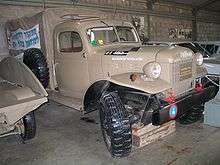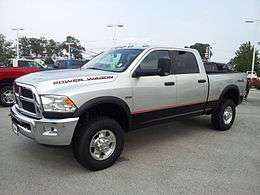Dodge Power Wagon
| Dodge Power Wagon | |
|---|---|
 | |
| Overview | |
| Manufacturer | Dodge (Chrysler) |
| Production | 1945–1980 |
| Model years | 1946–1980 |
| Assembly | Warren, Michigan, United States |
| Body and chassis | |
| Class | Full-size pickup truck |
| Layout | Front engine, four-wheel drive |
| Related |
Ocdresto Classic truck resto Legacy Dodge Carryall |
| Powertrain | |
| Engine | |
| Dimensions | |
| Wheelbase | 126 in (3,200 mm)to a 147" wheelbase on some models |
| Chronology | |
| Successor | Dodge Ram |
The Dodge Power Wagon is a four wheel drive light truck that was produced in various model series from 1945 to 1981 by Dodge, then as a nameplate for the Dodge Ram from 2005 to 2013, and, most recently, as an individual model marketed by Ram Trucks.
The original civilian version, commonly called the "flat fender" Power Wagon or FFPW, was based on Dodge's 3/4 ton WC series of World War II military trucks. The civilian Power Wagon continued the Dodge lineage of four wheel drive trucks from the 1930s, proving basic four wheel drive design concepts and representing a significant predecessor to the many four wheel drive trucks in modern use today. Updated variants continued in production until 1980.
Following Chrysler Corporation policy of badge engineering to provide a greater number of sales outlets overseas, Power Wagons were also marketed around the world under the Fargo and De Soto badges.
History
Derived from the Dodge 3/4 ton WC series World War II military trucks, the Power Wagon was introduced in 1946 as the first civilian 4×4. Meant to compete with military-based Ford/Marmon-Herrington and GMC trucks, it had an enclosed all-weather civilian cab and a purpose-designed 8-foot cargo box. It had a 126 inch (3,200 mm) up to a 147" wheelbase chassis and featured the 230 cubic-inch flathead inline-six engine, a two-speed transfer case, a 4-speed manual transmission with a power take off (PTO) which would send power front or rear for operating auxiliary equipment, and 9.00/16-8 ply tires on 16×6.50 inch 5-stud wheels. In 1961 the 230 was replaced with the 251 cubic-inch flat head six.[1]
The nominal one-ton rated Power Wagon's gross vehicle weight rating (GVWR) was 8,700 pounds. Its maximum payload was 3,000 pounds. A big-block 383 V8 engine became an option starting in 1967. From 1961 to 1971 the body was called the "Sweptline," then transitioned to a more modern body image from 1972 through 1980 with varied grilles and paint schemes. In 1975 the 4-wheel drive became full-time with a 2-speed transfer case; this was changed back to part-time 4-wheel drive in 1980 due to the energy crisis. A huge boost in sales followed the 1974 release of the extended "Club Cab," popular with families and camper towing. The 4-door Crew Cab was far less common and is quite desirable to collectors for restoration. Utility and function was unmatched by few competing models, as the towing, payload, and snow plowing capacity of the Power Wagon equipped with "Dana 60" 8-lug axles was very popular with municipal and regional road crews.
The Power Wagon was sold through the 1980 model year. A number of engineering and styling improvements were made over the years as the truck grew in size and weight, but the basic package remained generally constant throughout its life and underwent one last major body change in 1972.
Variants
Civilian 1-ton Power Wagon "Military-Type, Flat Fender Style
First Series: late 1945-50 Includes the following years and model numbers: 1945-47 WDX; 1948-9 B-1-PW; 1950 B-2-PW; Additional Distinguishing Features: (4) rectangular stake pockets on each side of the bed; round speedometer with a rectangular gauge cluster on each side. The two rectangular gauge housings have the instrument lettering on the glass instead of the face of the gauge.
Second Series: 1951-(early)56 Includes the following years and model numbers: 1951 B-3-PW; 1952- early 53 B-3-PW; late 1953 B-4-PW; 1954 C-1-PW; 1955- early 56 C-3-PW; Additional Distinguishing Features: (3) slightly curved stake pockets on each side, bed sides are stamped. Looking at these bed sides from the rear, the top rail section of the bed angles out at 45 degrees with a rounded top edge. Group of 4 gauges in center of dash (Fuel, Amp, Temp, Oil) with silver/grey faces.
Third Series: 1956(late)-71 Includes the following years and model numbers: Late 1956 C-4-PW; 1957 W300; 1958-9 W300M; 1960-71 WM300; Additional Distinguishing Features: (3) square stake pockets on each side with stamped bed sides. Looking at the bed sides from the rear, the top of the bed is flat, with a rounded edge. Group of 4 gauges in the center of dash (Fuel, Amp, Temp, Oil) with black faces. NP420 Synchronized Transmission also used.
Third Series EXPORT: 1957-78 M601 open cab, flat faced cowl models and M615 ambulance
W100 and W200
The first light-duty civilian Power Wagons came out in 1957 with the introduction of the W100 and W200 pickups and panel trucks, Town Wagon (with rear side windows) and Town Panel without rear side windows (beginning in 1957 1⁄2-ton 2WDs were D100s and 4WDs were W100s). These trucks featured conventional cabs and front sheet metal and the cargo boxes used on the 2WD models. Their 4WD mechanical components—axles, transfer cases and transmissions—were sourced from outside manufacturers. Chrysler Corporation owned the New Process Gear Company (competitors generally used Spicer (Dana) transfer cases and Borg-Warner or in-house transmissions). http://www.townwagon.com/
W300
A one-ton W300 light-duty/civilian type Power Wagon was released in 1958.
W500 and W600
The two-ton W500 Power Wagon (only a chassis cab was built) was introduced in 1956 as the C3-HW, and lasted through the 1971 model year. This was replaced in 1972 with the W600 (also cab and chassis only), which was produced until 1977, when all Dodge medium-duty models were discontinued. To compensate for the loss of the medium-duty W600 a new W400 chassis cab was introduced in 1977.
Willock Chassis Swivel
From about 1952 through 1958 an option known as the Willock Chassis Swivel was available. With this option the frame was split into two pieces at the point where the bed of the truck met the rear of the cab. A longitudinal swivel system allowed these two pieces to rotate with respect to each other, with the result that almost without regard to the terrain all four wheels would always be on the ground. Somewhere between 50 and 100 examples were built. While Willock is no longer in business the chassis swivel is still manufactured by third-party vendors and can be incorporated into existing vehicles.
Replacement by Dodge Ram
The Power Wagon nameplate was discontinued in 1981 with the introduction of the Dodge Ram, with the four-wheel-drive models being sold under the "Power Ram" nameplate through 1993. 1989 to 1993 models saw the addition of an optional 6-cylinder Cummins Turbo-diesel engine.
First generation gallery
 Power Wagon WM-300. This model was sold into the mid-1960s
Power Wagon WM-300. This model was sold into the mid-1960s 1963 Power Wagon ambulance, on display at Malmstrom Air Force Base, Montana
1963 Power Wagon ambulance, on display at Malmstrom Air Force Base, Montana 1942 Fargo Power Wagon truck in Batey ha-Osef Museum, Israel.
1942 Fargo Power Wagon truck in Batey ha-Osef Museum, Israel. Red Dodge Power Wagon
Red Dodge Power Wagon Custom conversion to 6 wheel drive
Custom conversion to 6 wheel drive 1976 Dodge W200 CUCV
1976 Dodge W200 CUCV- 1958 WM-300 carryall in US Navy livery
2005–present
For 2005, Dodge resurrected the Power Wagon name on a version of the Dodge Ram 2500. It was a special off-road version of the Ram 2500 with a 5.7L Hemi V8 as the only engine option. As of 2014, the only engine available is the 6.4L Hemi. Interior configurations remain similar to standard production Ram. As of 2010, the Power Wagon is only available as a Crew Cab Short Bed model. Special features of the Power Wagon include:
- Electronically controlled locking differentials (front and rear)
- Electronically disconnecting front sway bar
- Integrated 12,000 lb electric Warn winch
- 17 inch diameter Alcoa forged wheels
- Large 33 inch diameter BF Goodrich All Terrain T/A 285/70R17 tires. Replaced by Goodyear Duratracs beginning with the 2014 model year.
- Bilstein Monotube Gas Charged Shocks[2]
- Extensive skidplating: front stabilizer bar, transfer case, fuel tank, special skid plate crossmembers welded to the frame with open bars bolted to them across the midsection.
- 1.4" factory lift in front, 1.0" in rear (0.4" front and rear due to larger tires). Softer rate springs.
- Strengthened torque converter
- 4.56:1 axle ratios (4.10 as of the 2014 model)
- Revised clutch fan
- Strengthened steering gear
- Low range 4x4 throttle mapping changed.
Upgraded suspension and larger tires naturally give the truck a taller ride height. Clearance lights and tow hooks are standard equipment. Fender flares are standard equipment as well. The fender flares assist with tire coverage due to the Power Wagon's wider tires.
Powertrain
6.4 L Hemi V8
Transmission
A six speed manual transmissions was standard, with an automatic transmission optional. As of 2010 the manual transmission is no longer an option. 2012 models have the 66RFE 6 speed automatic transmission, instead of the 545RFE 5 speed automatic in the previous models.
Transfer case
The transfer case was a New Venture 271 and had a 2.72:1 low range gear ratio. A transfer case skid plate was and is standard equipment. A manual shift-on-the-fly transfer case is the only available, the electronic shift on-the-fly has never been an option. As of the 2012 model year, the transfer case has changed to a Borg-Warner 44-47 manual shift-on-the fly. Low range is now 2.64:1.
Axles
The axles are manufactured by American Axle & Manufacturing, Inc. The front is an AAM 9.25 and the rear is a hybrid AAM 10.5 with the larger axle shafts from the AAM 11.5. Despite the fact the axles have locking differentials, the rear axle is also a helical-type limited slip differential when unlocked. The axles are only available with a 4.56:1 gear ratio. Non Power Wagon 2500 Ram trucks only have 3.42:1, 3.73:1, or 4.10:1 gear ratios. 2010 models (along with other Ram trucks) received larger universal joints.
2012 Weight ratings:
- GVWR - 8510 lbs
- GCWR - 17,000 lbs
- GAWR (front) - 4500 lbs
- GAWR (rear) - 6200 lbs
- Max payload - 1880 lbs
- Max towing - 10,250 lbs
- Curb weight - 6800 lbs
2013 updates
The New Venture Gear transfer case is replaced by a Borg-Warner unit. Interior updated ala 1500 Rams.
2014 updates
The RAM Power Wagon will have a 6.4 Hemi V8 as the standard engine; the 5.7 Hemi V8 goes away. The 6.4 has 410 horsepower and is also available in standard Rams. The transmission and transfer case remain unchanged (Borg Warner 44-47). The axle gears change from 4.56:1 gear ratios to 4:10 gear ratios. The rear axle is now a 11.5 AAM axle (with selectable locker). The rear suspension now has a 5-link coil spring arrangement instead of leaf springs. The front suspension has been changed to a radius arm arrangement (3-link) instead of the 5-link used since 2005. Tires are now Goodyear Duratracs.
|
See also
- Dodge WC series
- Dodge W-series/Power Ram
- Dodge Town Panel and Town Wagon, available as Power Wagon carryalls
- List of Dodge automobiles
- Commercial Utility Cargo Vehicle
References
http://www.vintagepowerwagons.com/#!1-ton-flat-fender-dodge-power-wagon/oh69f
http://www.vintagepowerwagons.com/#!vehicle-identification/kowx1
External links
| Wikimedia Commons has media related to Dodge Power Wagon. |
- Dodge Power Wagon
- Dodge Power Wagon forums & magazine page
- 1961-71 Dodge Truck Website(Power Wagon)
- Eric's Power Wagon Page
- Power Wagon Registry (2005 and up)
- Power Wagon Forum
- Power Wagon Canada - New and Vintage Power Wagons
